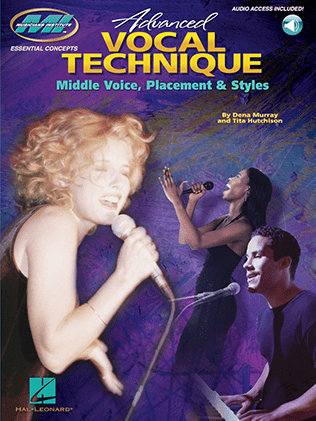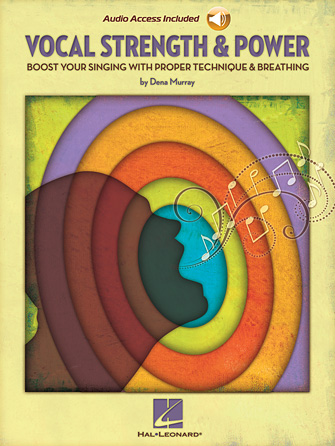
Master Vocal Technique Teacher/Coach for Singers, and Published Author
Books
Excerpt from Vocal Technique: A Guide to Finding Your Real Voice
Controlling the Flow of Air
When the cords aren’t able to keep the stretch for the resistance needed, the voice will feel like it’s losing power. To compensate for this loss of power, or “weight,” the tendency is to add more breath pressure for loudness. Without knowing how to rely on the vocal cords for the kind of resistance and weight needed, you rely on the breath to do it by adding pressure against it to force the voice out. This is what is known as overblowing, or pushing.
Pushing blows the mechanism apart by forcing so much air through the cords that they don’t have an opportunity to adjust for the pitch until after the air has already started coming out. If the cords don’t have enough stretch to create the resistance needed to control the flow of air, this will cause the air to escape too rapidly. Realizing you might not have enough to get to the end of the phrase, you begin to squeeze, hoping to save as much of it as you can. But if the breath is meant to take the voice out of you, how can it do that if it’s being squeezed? Take an object in your hand and squeeze it. Can it break free? Squeezing the air to hold it in is only keeping the sound from coming out, and holding the breath makes you feel like you can’t breathe! Though it’s very true that the breath can add loudness and resonance to your voice, it can only do so if it is expelled properly.
Right Breathing, Everyday Breathing
The breath may not be the most important factor in voice, but if you’re not breathing right it becomes the most important factor. So to get the idea of what it means to breathe right, let’s start with normal, everyday breathing.
When you take a breath in through the mouth, the stomach automatically expands. When you slowly exhale, it contracts. To demonstrate, sit in a chair with your feet firmly planted on the floor. Relax and sit back. Start by taking in a deep breath through your mouth and then exhaling it. Allow yourself to hear the breath as you take it in—a “noisy” breath—and then exhale it. Pay attention to your stomach. Feel it expand on the inhale, and contract on the exhale. Put your hands on your shoulders to make sure they are not rising up on intake. If they rise up, it means you are not taking the breath in deep enough. The idea of this exercise is to experience your breathing as one continuous action, just as it is when you are sitting still with yourself.
When you take in a breath, concentrate on whether you are holding it for a second, and then starting the exhale. If you are, this is what I refer to as a “start-and-stop.” Every time you take a breath in and then stop it before exhaling, it means that you are holding the breath. Holding the breath in any way creates pressure underneath the cords, forcing them to release too much air all at once. If you find that you are starting and stopping, try to stop this habit before proceeding.
To sing with ease and freedom, the vocal cords and the breath must be working as a team. This means that the action between the two must be a simultaneous one. Taking in the breath and starting the note must occur at exactly the same moment. One cannot come out before the other. If it does, it will require some kind of body effort on your part to make it work. The entire goal here is to make this an involuntary action; to have your voice work the way nature intended. After all, the mechanism of the human voice is an organ that lives inside of your body, and—just like any other organ—is ultimately meant to be working independently of you.
Excerpt from Advanced Vocal Technique: Middle Voice, Placement, & Styles
The Recording Can't Lie
Your voice must become the student and you must become the guide. To do this, you will have to record your voice on a device that you can easily keep rewinding after every attempt. Good or bad will keep you judging in a negative way, but right or wrong will keep you evaluating and in the teacher/guide mode. We refer to this as listening from a higher perspective.
Listening back to yourself will help you to pay more attention to breaking your bad habits and less attention to the sound. Nine times out of ten, the reason a voice is not going to the right places, and not bridging, is because there are bad habits in the way. It’s these bad habits that are keeping you from having what you want. And without recording, it’s easy to fool yourself. Sometimes things won’t feel right but you’ll rationalize that you are “getting it” because of the way you think it sounded, rather than the way it felt. With regard to bridging, middle voice, and placement, you will have to rely on the recording you hear, along with feeling and sensation, and not how it sounds to you at the time you perform the exercise.
Remember this: You can’t do it right until you have done it wrong, and you can’t do it well until you have done it badly.
Excerpt from VOCAL STRENGTH & POWER: Boost Your Singing with Proper Technique and Breathing
Who Needs Vocal Technique?
Every voice requires maintenance to prevent problems created by the heavy demands of professional singing. Many famed singers sing instinctively, without thinking about it. Some of them will never take lessons because their voice is the one thing they know that has never failed them. Between their singing, performance skills, and their own brand of magic, they have become stars, but there might come a time when their voice gives out. Many singers don’t care and just change the keys of their previous works so they can still sing them. Others change their style somewhat so the voice is less taxed. Still others continue trying to sing the songs they once sung easily, but aren’t able to hit the high notes anymore. Without proper training, the singer is then faced with a choice: learn how to sing correctly, or lose the voice – sometimes the career.


